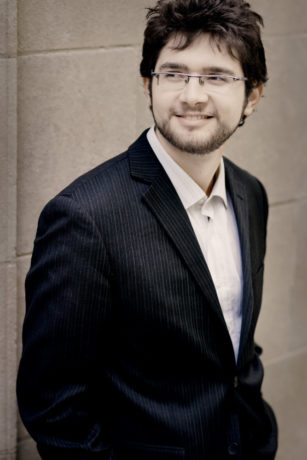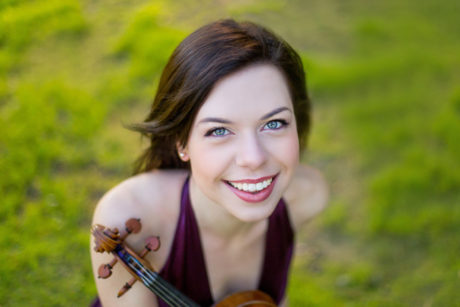Nothing is quite as draining as endless discussions in the classical music world about how concerts “should” work to recapture their prominence in the cultural fabric. So nothing is quite as satisfying as a concert that actually pulls it off, with a combination of old and new works that are completely authentic to the performers in question rather than an exercise in checking boxes.
When you consider classical music’s roots in performers mainly playing their own compositions, and when you realize the overlap with how pop music works today, then you can understand why violinist Tessa Lark’s appearance last Sunday in the Phillips Collection’s weekly concert series was a touchstone of the Washington concert season.

Lark’s performance specialty is communicative immediacy, removing the violin from its above-it-all “diva” status among orchestra instruments into a direct narrative interplay with the audience’s ears. Partnering with pianist Roman Rabinovich, Lark presented five works: two of her own, one of his, and one each by Johannes Brahms and Bela Bartok.
The biggest highlights were a performance of Bartok’s rather enormous Sonata No. 1 for Violin and Piano from 1921, and a piece from almost 100 years later – meaning, therefore, right now – by Rabinovich himself, Two-dot Wings, written specifically for Lark’s technical style and performance vibe.
The Bartok sonata takes the composer’s Hungarian folk roots, twirling and twisting (and occasionally hammering) the themes into more abstract shapes reflective of the post-Romantic mandate of the world of music after World War I. He then adds suggestive sound effects, like the crawl and buzz of insects, to give listeners some touchpoints to relate to concrete phenomena. The challenge for both the violinist and pianist – a challenge which both Lark and Rabinovich clearly relish – is almost one of persuasion: “Stick with us; we know this may be rough going at first, but it’s heading somewhere you’ll like or at least get something out of.” The piece moves over time from a more academic, dissonant sound filled with jagged edges into one in which the Eastern European, gypsy-related folk roots more clearly emerge out of Bartok’s sound world.
During the second of three long movements, a clever touch in the piano part that sounds like complex jazz chords slowly rising out of the bottom of the keyboard eventually sets up a series of higher, more complicated intervals in “double-stops” or simultaneously played notes in the violin. Lark’s notable transparency where her shifting sequences of two simultaneous notes sounded as easy to play on the violin as the piano (which of course they are not) helped fuse the parts together and create that sense of anticipation.

Music theorists might say that Bartok really picked up these intervals from the music of the then recently deceased French composer Claude Debussy, who liked to write in these kind of anticipatory “whole tone” scales that lack immediately adjacent notes leading to a conventional resolution. Whether it’s heard today as complicated “jazz” or not, it was a great lead-in to the rollicking, at times simply wild, third movement that enabled both violinist and pianist to display their virtuoso chops in this final movement’s cross of folk, gypsy, and bitingly astringent “serious” 20th century music.
Regarding Rabinovich’s composition, for once I’m not embarrassed to accede to classical music’s pretentious habit of calling the first performance of everything a “world premiere.” Returning to the theme of nature, but this time more explicitly, Two-dot Wings represents the transitions from egg to caterpillar to butterfly. The difference between the creep of a caterpillar and the joyous flight of a butterfly are directly represented in the energy of the music, and Rabinovich injects an element that so many contemporary composers forget: humor. Sliding notes, syncopated rhythms, and even percussion effects in the violin help represent the life of this creature, and the listener almost gets the sensation of “training wheels” from Lark and Rabinovich’s accelerating performance as the butterfly gains confidence to fly away.
The concert opened with the first of Johannes Brahms’ three sonatas for violin and piano, written in conventional Romantic tonality with Brahms’ signature mix of melancholy and rich lyricism. In live performance, Lark handled this piece in a way that reminds me of a theater actor’s dictum to never go out of character even when you don’t have any lines. Many, if not most, soloists tend to look distracted when only the piano is playing, but she remained completely absorbed in the music and the moment – even in the silence between the three movements where most classical performers go out of their stage persona for the piece.
Lark and Rabinovich also clearly agreed on a tactic that you rarely hear in performances of Romantic-era music. Brahms’ large-scale compositions, like sonatas, concertos, and symphonies, invariably contain a major flourish at the end of the first movement, an easy point of confusion for newer listeners who may not realize that the piece is not over. In this concert, the two performers hit the final note of the first movement but then deliberately pulled it back in volume, a striking sublimation of the performer’s ego in service of the greater good.
The Brahms sonata also served as a demonstration of one of Lark’s calling cards, an almost completely even tone color across the violin’s entire range, as opposed to many violinists’ tendency for their lower notes to sound grainy and their higher notes to sound sweeter. That said, there’s still a broad middle range in her playing of Brahms and presumably other, older composers that picks up a beautiful merlot-colored dark lyricism. It will be fascinating to see how this sound continues to evolve over the course of her career.

Lark’s own works on the Phillips program began with her piece called Appalachian Fantasy, which features among other things a drone figure on the violin’s D string while country music inflected figures are spun above. In an effective spoken introduction to the audience, Lark was careful to distinguish the mountain tunes she used from straight bluegrass music, all of which builds on her Kentucky background as she discussed in my recent interview with her.
She also performed her own arrangement of Martin Rojas’s En la orilla del mundo (“At the Edge of the World”) that she first heard on Charlie Haden’s Nocturne album, showing her Latin jazz arrangement and performance chops that are also part of her calling. An encore of Clara Schumann’s Romance No. 1 provided a cleverly counterintuitive quiet and conventionally Romantic end to an afternoon of largely inventive and sometimes even raucous music-making.
Nothing says that an audience member has to like everything equally on such performers’ programs, and it’s typical of the Phillips series that programs such as Lark’s spark conversation and open engagement that can be lacking elsewhere. Probably the next step to be hoped for is that one of Washington’s major suburban orchestras that perform in large halls, like the Music Center at Strathmore in North Bethesda or George Mason University in Fairfax, will engage Lark in either existing repertoire or one of multiple new violin concertos that are being written for her by other contemporary composers. When it comes, that event will be one not to be missed by much more than the usual classical crowd.
Running Time: 2 hours, with one 15-minute intermission.
Violinist Tessa Lark and Pianist Roman Rabinovich performed Sunday, December 10, 2017 at 4 p.m. in the Phillips Collection’s Sunday concert series. During the current renovation at the Phillips, the concert took place next door to the Phillips in the Warne Ballroom of the Cosmos Club, 2121 Massachusetts Avenue NW, in Washington, DC. For the remainder of Phillips’ Sunday concert season schedule, see the Phillips Music website. For Tessa Lark’s national list of upcoming performances, see her complete concert schedule.




